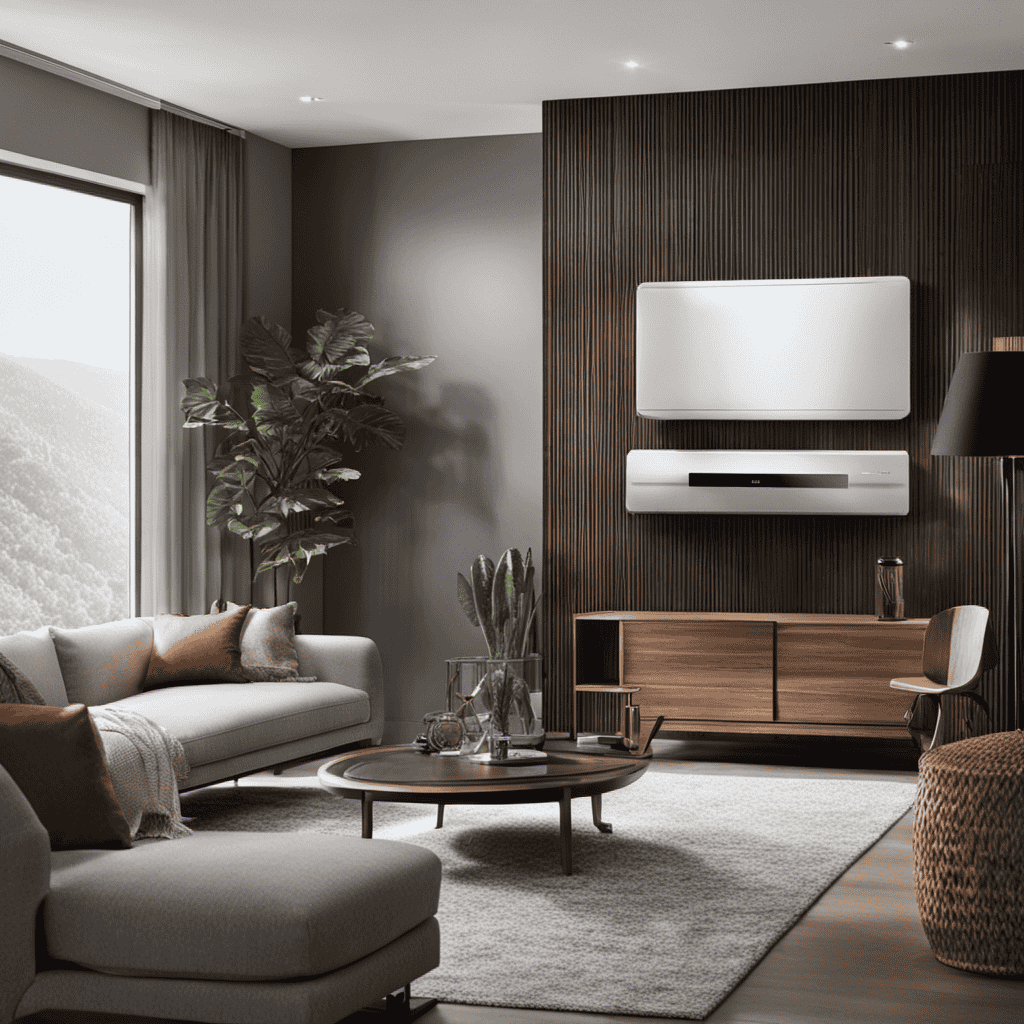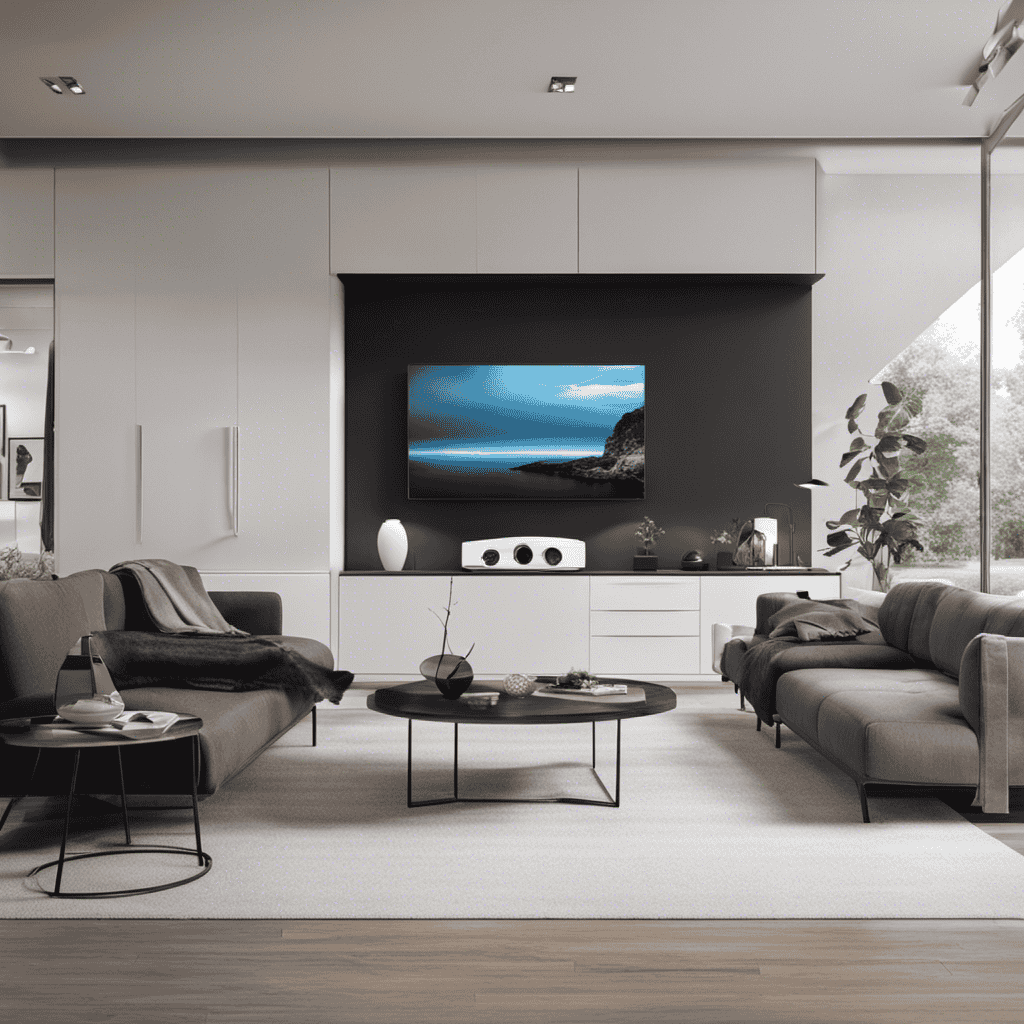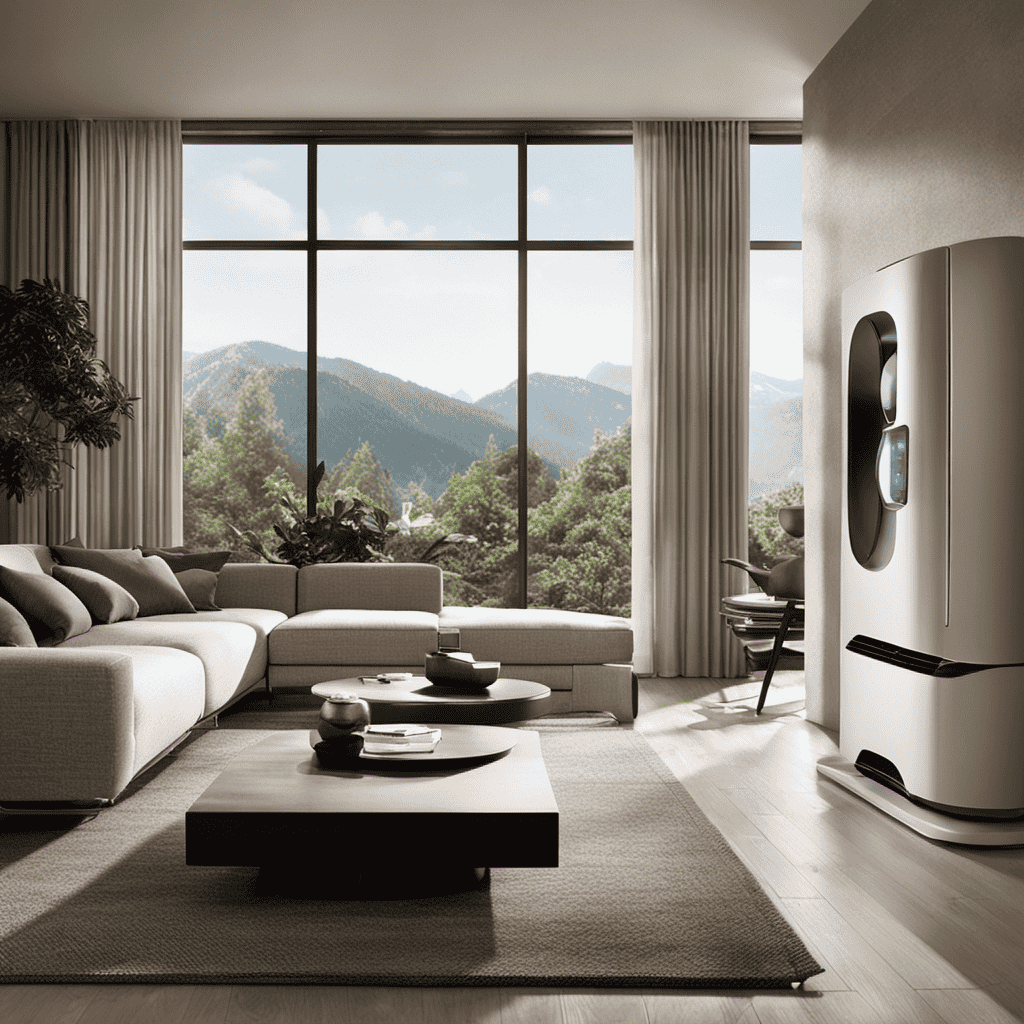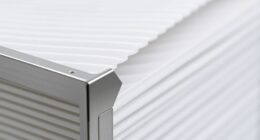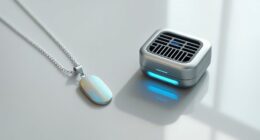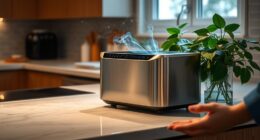As someone who is passionate about air purification, I understand the importance of maintaining my Levoit Air Purifier to ensure clean and fresh air. That’s why I am excited to share with you the ultimate guide on Levoit Air Purifier Filter Replacement.
Imagine the feeling of breathing in pure, filtered air every day. In this article, I’ll walk you through the signs that indicate it’s time to replace your filter, how to choose the right replacement, where to buy them, and a step-by-step guide to effortlessly replace your Levoit Air Purifier Filter.
Let’s get started!
Key Takeaways
- The Levoit Air Purifier Filter uses a three-stage filtration system: pre-filter, True HEPA filter, and activated carbon filter.
- The filter should be replaced every 6-8 months or more frequently in polluted areas.
- Neglecting to replace the filter can result in decreased air purification, so it’s important to regularly check the filter replacement indicators.
- Keeping spare filters on hand can help avoid downtime and ensure timely filter replacement.
Understanding the Levoit Air Purifier Filter
To understand the Levoit Air Purifier Filter, you’ll need to know how it works and what it filters out.
The Levoit Air Purifier Filter is designed to effectively remove airborne pollutants from the air in your home. It uses a three-stage filtration system to capture particles as small as 0.3 microns.
The first stage is the pre-filter, which helps to trap larger particles like dust and pet hair. Next, the True HEPA filter captures smaller particles such as pollen, mold spores, and pet dander. Finally, the activated carbon filter removes odors and harmful gases from the air.
To prepare the filter for use, simply remove the plastic packaging and insert it into the air purifier. Filter maintenance is important to ensure optimal performance. It is recommended to replace the filter every 6-8 months, or more frequently if you have pets or live in a highly polluted area. Regularly checking and cleaning the filter can also help prolong its lifespan.
With proper care, the Levoit Air Purifier Filter will continue to provide you with clean and fresh air in your home.
Now, let’s discuss the signs that it’s time to replace your Levoit Air Purifier Filter.
Signs That It’s Time to Replace Your Levoit Air Purifier Filter
When it comes to maintaining the efficiency of my Levoit Air Purifier, two key points I always keep in mind are the filter replacement indicators and the potential for decreased air purification.
The filter replacement indicators are designed to let me know when it’s time to replace the filter, ensuring that the purifier continues to work effectively.
If I neglect to replace the filter when indicated, I may experience decreased air purification, as the filter becomes clogged and unable to effectively capture pollutants.
Filter Replacement Indicators
The Levoit air purifier has filter replacement indicators that notify you when it’s time to change the filter. These indicators are a helpful feature that ensures the efficiency and effectiveness of your air purifier. When the filter replacement indicator is triggered, it’s important to follow the manufacturer’s instructions for replacing the filter. Proper filter maintenance is crucial for optimal performance and longevity of your air purifier. Here are some filter maintenance tips to keep in mind:
| Filter Maintenance Tips | Importance |
|---|---|
| Regularly check the indicator | Ensures timely filter replacement |
| Follow manufacturer’s instructions | Proper installation and replacement |
| Keep spare filters on hand | Convenient and avoids downtime |
| Clean pre-filters regularly | Enhances filter lifespan |
| Monitor air quality | Helps determine filter replacement frequency |
Decreased Air Purification
Regular cleaning and maintenance can help address decreased air purification in your purifier. Over time, dust, dirt, and other pollutants can accumulate on the filters, reducing their effectiveness and causing a decline in air quality. To prevent this, here are three important steps you can take:
-
Clean or replace filters regularly: Check the manufacturer’s instructions for recommended cleaning intervals and methods. Some filters can be washed, while others need to be replaced entirely. By keeping your filters clean, you ensure that they can efficiently capture pollutants and maintain optimal air purification.
-
Keep the purifier in a clean environment: Avoid placing the purifier in dusty or dirty areas. Regularly dust and vacuum the surrounding area to minimize the amount of airborne particles that can clog the filters.
-
Monitor air pollution sources: Identify and minimize sources of air pollution in your home, such as smoking, cooking emissions, or pet dander. By reducing these pollutants, you can help prolong the lifespan of your filters and improve overall indoor air quality.
Choosing the Right Replacement Filter for Your Levoit Air Purifier
When it comes to choosing the right replacement filter for your Levoit Air Purifier, there are two key points to consider: filter compatibility options and replacement frequency guidelines.
Firstly, filter compatibility options refer to the different types of filters that are compatible with your specific air purifier model. It is essential to ensure that the replacement filter you choose is specifically designed for your Levoit Air Purifier to ensure optimal performance.
Secondly, replacement frequency guidelines provide recommendations on how often you should replace the filter to maintain clean and healthy air quality in your home.
Filter Compatibility Options
Check out the different filter compatibility options and find the one that suits your Levoit air purifier best. When it comes to replacement filter options for Levoit air purifiers, there are a few factors to consider. Here are three important things to keep in mind:
-
Model-specific filters: Levoit offers replacement filters designed specifically for each model of their air purifiers. These filters are optimized to provide the best performance and fit perfectly into your device.
-
HEPA filters: Levoit air purifiers use HEPA filters, which are highly effective at capturing airborne particles, allergens, and pollutants. Make sure to choose a replacement filter that is HEPA-certified for optimal purification.
-
Filter maintenance techniques: To prolong the lifespan of your filters, it’s important to follow proper maintenance techniques. This includes regular cleaning, replacing filters on time, and avoiding exposure to excessive moisture or heat.
Replacement Frequency Guidelines
To optimize the performance of your device, it’s important to keep in mind the recommended frequency for replacing your air purifier’s filters. Regularly changing your air purifier’s filters is crucial for maintaining clean and healthy indoor air quality.
The filter replacement schedule typically varies depending on factors such as the model of the air purifier and the level of air pollution in your surroundings. On average, it is recommended to replace the filters every 6 to 12 months. However, it’s always a good idea to consult the user manual or contact the manufacturer for specific guidelines.
Regular filter changes offer numerous benefits, including improved air purification efficiency, reduced allergens, and better overall performance of your air purifier. By staying on top of the filter replacement schedule, you can ensure that your device continues to provide you with clean and fresh air.
Where to Buy Levoit Air Purifier Replacement Filters
You can easily find Levoit air purifier replacement filters at various online retailers. Here are three options to consider:
-
Amazon: Amazon offers a wide range of Levoit air purifier replacement filters, including different brands and models. They often have competitive prices and convenient shipping options.
-
Levoit Official Website: The official Levoit website is another reliable source for purchasing replacement filters. They offer genuine Levoit filters and provide detailed product information to help you make the right choice.
-
Home Improvement Stores: Some home improvement stores, such as Home Depot and Lowe’s, also carry Levoit air purifier replacement filters. They may have a limited selection, but you can often find them at competitive prices.
When shopping for Levoit air purifier replacement filters, it’s essential to compare prices and consider any additional costs, such as shipping fees or taxes. By doing so, you can ensure that you get the best deal possible.
Now, let’s move on to the step-by-step guide to replacing your Levoit air purifier filter.
Step-By-Step Guide to Replacing Your Levoit Air Purifier Filter
When it comes to maintaining the longevity of your Levoit air purifier, there are a few key tips to keep in mind.
First, regularly clean the exterior of the purifier with a soft cloth to remove any dust or debris.
Second, make sure to replace the filters according to the manufacturer’s recommendations to ensure optimal performance.
Lastly, when disposing of the filters, it is important to follow proper methods to minimize any potential environmental impact.
Maintenance Tips for Longevity
Regularly cleaning and replacing the filters in your Levoit air purifier can help extend its lifespan. To prevent filter clogs and ensure optimal performance, here are some cleaning techniques to consider:
-
Vacuuming: Gently vacuum the surface of the filter to remove dust and debris. Be careful not to damage the filter during this process.
-
Rinsing: If your filter is washable, rinse it under running water to remove trapped particles. Allow it to dry completely before reinstalling.
-
Brushing: Use a soft brush to gently remove dust and dirt from the filter. This method is particularly effective for pre-filters.
By following these cleaning techniques, you can maintain the efficiency of your Levoit air purifier and prolong its lifespan.
Now, let’s discuss proper filter disposal methods to ensure eco-friendly practices.
Proper Filter Disposal Methods
Now that we have covered maintenance tips for extending the longevity of your Levoit air purifier filter, let’s talk about proper filter disposal methods. It is important to dispose of your used filters in an eco-friendly manner to minimize environmental impact. Here are some options for eco-friendly filter disposal:
| Option | Description | Benefits |
|---|---|---|
| Recycling Centers | Many recycling centers accept air filters for proper disposal. | Reduces waste and promotes recycling. |
| Manufacturer’s Recycling Program | Check if Levoit has a recycling program for their filters. | Ensures proper disposal and potentially supports a circular economy. |
| Local Hazardous Waste Facility | Some facilities accept filters as hazardous waste due to potential contaminants. | Prevents pollution and protects the environment. |
| Donate for Reuse | If your filters are still in good condition, consider donating them to someone in need. | Extends the lifespan of the filter and helps others save money. |
Preparing Your Levoit Air Purifier for Filter Replacement
To prepare your Levoit Air Purifier for filter replacement, make sure to turn off the power and unplug the device. This is an essential step to ensure your safety and prevent any electrical mishaps.
Once you have done that, follow these maintenance techniques:
- Remove the front cover of the air purifier by gently pulling it towards you.
- Take out the old filter carefully and dispose of it according to proper methods.
- Clean the inside of the purifier using a soft cloth or brush to remove any dust or debris.
By following these preparing methods, you are ensuring that your Levoit Air Purifier is ready for the next step of replacing the old filter with a new one.
Now let’s move on to the next section and learn how to remove the old filter from your Levoit Air Purifier.
Removing the Old Filter From Your Levoit Air Purifier
When removing the old filter, be sure to gently pull the front cover towards you to access it. The Levoit air purifier is designed for easy maintenance, and replacing the filter is a simple process. To ensure optimal performance, it’s important to regularly check and replace the filter.
Here are some maintenance tips and troubleshooting issues you may encounter:
-
Maintenance Tips:
-
Clean the pre-filter regularly to remove larger particles and extend the life of the main filter.
-
Replace the filter every 6-8 months, or as recommended by the manufacturer.
-
Keep the air purifier in a well-ventilated area to maximize its efficiency.
-
Troubleshooting Issues:
-
If the air purifier is not turning on, check the power cord and make sure it is properly plugged in.
-
If the air purifier is not effectively removing odors or allergens, consider replacing the filter or adjusting the fan speed.
Before installing the new filter, it’s important to clean the air purifier housing to remove any dust or debris that may have accumulated.
Cleaning the Air Purifier Housing Before Installing the New Filter
Before installing a new filter in your Levoit air purifier, it’s important to clean the pre-filter first. This step is crucial as it helps to ensure the efficiency and effectiveness of your air purifier.
Properly cleaning the pre-filter ensures that any accumulated dust, debris, or pet hair is removed, allowing the new filter to work optimally and prolonging its lifespan.
Additionally, it’s essential to follow the manufacturer’s instructions for proper filter installation to ensure a secure fit and maximum filtration performance.
Pre-Filter Cleaning Importance
Regularly cleaning the pre-filter is crucial for maintaining the effectiveness of the Levoit air purifier. The pre-filter is the first line of defense against larger particles such as dust, pet hair, and pollen.
Here are three important reasons why pre-filter maintenance is essential:
-
Improved Air Quality: A clean pre-filter ensures that larger particles are efficiently captured, preventing them from circulating back into the air. This leads to cleaner, fresher air for you and your family to breathe.
-
Extended Filter Life: By regularly cleaning the pre-filter, you can prolong the lifespan of the main filter. A clean pre-filter reduces the workload on the main filter, allowing it to trap smaller particles more effectively and last longer.
-
Enhanced Purifier Performance: When the pre-filter is clean, the air purifier can operate at its optimal performance level. With a clear pre-filter, the air purifier can draw in and filter air more efficiently, improving its overall effectiveness in removing airborne contaminants.
Proper Filter Installation
To properly install your filters, make sure to follow the instructions provided in the user manual. This is essential for preventing filter damage and maximizing filter effectiveness.
When installing a new filter, start by turning off the air purifier and unplugging it from the power source. Next, locate the filter compartment, usually located at the back or bottom of the unit. Open the compartment carefully, and remove the old filter by gently pulling it out.
Before inserting the new filter, make sure to remove any plastic packaging or protective covers. Align the new filter properly in the compartment, ensuring that it fits snugly. Finally, close the compartment securely and plug in the air purifier.
Installing the New Levoit Air Purifier Filter Correctly
Make sure you’re following the instructions correctly when installing the new Levoit Air Purifier filter. This is crucial for preventing filter damage and maximizing filter efficiency. Here are three important things to keep in mind:
-
Proper alignment: Ensure that the filter is aligned correctly with the arrows on the filter frame. This ensures a secure fit and prevents air leakage around the edges.
-
Gentle handling: Handle the filter with care to avoid any tears or punctures. Rough handling can damage the filter and compromise its effectiveness.
-
Regular replacement: Follow the recommended filter replacement schedule provided by Levoit. Regularly replacing the filter not only ensures optimal performance but also extends the lifespan of your air purifier.
By following these steps, you can install the new Levoit Air Purifier filter correctly and ensure its longevity.
Now, let’s move on to some valuable tips for maintaining the longevity of your Levoit air purifier filter.
Tips for Maintaining the Longevity of Your Levoit Air Purifier Filter
Here’s a valuable tip for extending the lifespan of your Levoit air purifier filter: handle it gently to prevent any tears or punctures. Proper filter maintenance and care are essential to ensure the longevity and effectiveness of your air purifier.
To help you maintain your filter, here are some important tips:
- Regularly clean the outer surface of the filter to remove dust and debris that may accumulate over time.
- Avoid placing the air purifier near sources of smoke, strong odors, or chemicals, as these can degrade the filter faster.
- Replace the filter according to the manufacturer’s instructions, typically every 6 to 8 months, or when the filter indicator light comes on.
By following these simple maintenance tips, you can maximize the lifespan of your Levoit air purifier filter and ensure that it continues to provide clean and fresh air for your home.
Now, let’s move on to troubleshooting common issues with Levoit air purifier filter replacement.
Troubleshooting Common Issues With Levoit Air Purifier Filter Replacement
If you’re experiencing any issues with your Levoit air purifier filter replacement, there are several common problems that can be easily troubleshooted. Here are three common problems and their solutions:
-
Filter not fitting properly: Ensure that you have purchased the correct replacement filter for your specific Levoit air purifier model. Double-check the dimensions and compatibility. If the filter still doesn’t fit, try gently adjusting it or contacting Levoit customer support for assistance.
-
Filter not filtering effectively: If you notice a decrease in air purification performance, make sure the filter is installed correctly with no gaps or leaks. Clean the pre-filter and check for any obstructions or excessive dirt buildup. If the issue persists, consider replacing the filter or getting professional maintenance.
-
Filter replacement reminder not resetting: If the filter replacement indicator light or alert does not reset after replacing the filter, try pressing and holding the reset button for a few seconds. If that doesn’t work, consult the user manual or reach out to Levoit customer support for guidance.
Importance of Regular Filter Replacement for Optimal Air Purification
Regularly replacing your air purifier’s filter is essential for maintaining optimal air purification. The frequency at which you should replace your filter depends on several factors such as the air quality in your home, the type of filter you are using, and the manufacturer’s recommendations.
Generally, it is recommended to replace the filter every 6 to 12 months. However, if you have pets or allergies, you may need to replace it more frequently, every 3 to 6 months.
To ensure you have the correct replacement filter, it is best to buy directly from the manufacturer or authorized retailers. These sources will provide you with genuine filters that are compatible with your Levoit air purifier model.
Understanding the different types of Levoit air purifier filters available will help you choose the right one for your specific needs.
Understanding the Different Types of Levoit Air Purifier Filters Available
Now that we understand the importance of regular filter replacement for optimal air purification, let’s dive into the different types of Levoit air purifier filters available.
When it comes to choosing the right filter for your Levoit air purifier, two key factors to consider are the filter size and the filter material.
-
Filter Size: Levoit offers a range of filter sizes to fit different models of their air purifiers. It’s important to choose the correct filter size to ensure proper installation and maximum filtration efficiency.
-
Filter Materials: Levoit air purifier filters are available in various materials, each with its own unique features and benefits. Some common filter materials include:
-
True HEPA Filters: These filters are highly effective in capturing 99.97% of airborne particles as small as 0.3 microns, such as dust, pollen, pet dander, and mold spores.
-
Activated Carbon Filters: These filters excel at removing odors, harmful gases, and volatile organic compounds (VOCs) from the air, making them ideal for households with smokers or pets.
-
Pre-Filters: These filters act as the first line of defense, capturing larger particles like dust and hair, and extending the lifespan of the main filters.
Frequently Asked Questions About Levoit Air Purifier Filter Replacement
When it comes to maintaining optimal air quality in your home, understanding the frequently asked questions about replacing your Levoit air purifier filters can help you make informed decisions. One of the most common questions is how often should you replace the filter? The answer depends on several factors such as the air quality in your home, the size of the filter, and how often you run the purifier. Generally, it is recommended to replace the filter every 6 to 8 months for optimal performance. Here’s a table summarizing the benefits of using a Levoit air purifier and its filter replacement frequency:
| Benefits of using a Levoit air purifier | Filter Replacement Frequency |
|---|---|
| Removes allergens and pollutants | Every 6 to 8 months |
| Improves indoor air quality | Every 6 to 8 months |
| Helps alleviate respiratory issues | Every 6 to 8 months |
| Reduces odors and pet dander | Every 6 to 8 months |
Tips for Extending the Lifespan of Your Levoit Air Purifier Filter
To help your filter last longer, you can try using a vacuum cleaner to remove any visible dust or debris from the surface. This simple step can go a long way in preventing filter clogging and maximizing filter efficiency.
Here are three additional tips to extend the lifespan of your Levoit air purifier filter:
-
Regularly clean the pre-filter: The pre-filter is the first line of defense for your air purifier. Cleaning it every 3-4 weeks can help prevent larger particles from reaching the main filter, reducing the risk of clogging and prolonging its effectiveness.
-
Avoid smoking or using candles near the air purifier: Smoke and soot can quickly accumulate on the filter, causing it to clog faster. By keeping these sources away from your air purifier, you can maintain optimal filter efficiency for longer periods.
-
Keep windows and doors closed: While it’s important to have proper ventilation, leaving windows and doors open can introduce more dust and pollutants into your space. By minimizing these external sources, you can reduce the strain on your filter and make it last longer.
Frequently Asked Questions
Can I Use a Different Brand of Air Purifier Filter With My Levoit Air Purifier?
Yes, you can use a different brand of air purifier filter with your Levoit air purifier. However, it is important to check if the replacement filter is compatible and meets the necessary specifications to ensure optimal performance and maintain your warranty.
How Often Should I Replace My Levoit Air Purifier Filter?
I replace my Levoit air purifier filter every 6-8 months. It’s important to keep in mind that the lifespan of the filter depends on various factors. You can buy replacement filters from authorized retailers or directly from Levoit.
Are Levoit Air Purifier Filters Washable and Reusable?
Yes, Levoit air purifier filters are washable and reusable. Regular cleaning of the filter helps maintain its effectiveness in removing pollutants from the air. Using washable filters not only saves money but also reduces waste.
Can I Use My Levoit Air Purifier Without a Filter?
I can’t use my Levoit air purifier without a filter. It’s an essential component for effective air purification. However, if you’re looking for alternative options, there are other air purifiers available that don’t require filter replacements. It’s important to prioritize air purifier maintenance for optimal performance.
What Is the Warranty for Levoit Air Purifier Filters?
The warranty for Levoit air purifier filters varies depending on the model and specific terms of purchase. To purchase replacement filters, you can visit the official Levoit website or check authorized retailers online.
Conclusion
In conclusion, regular filter replacement is crucial for maintaining optimal air purification with your Levoit Air Purifier.
One interesting statistic to note is that the average lifespan of a Levoit Air Purifier filter is approximately 6 to 8 months, depending on usage and air quality. This emphasizes the importance of staying vigilant and replacing the filter when necessary to ensure clean and healthy air in your home.
Remember to choose the right replacement filter and follow the step-by-step guide for a seamless filter replacement process.




